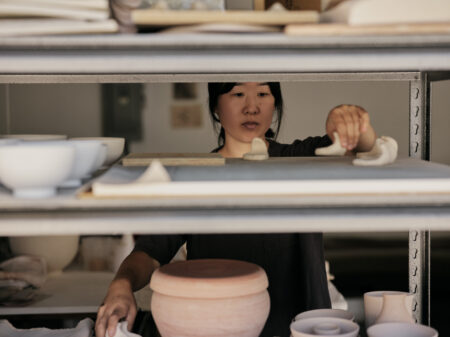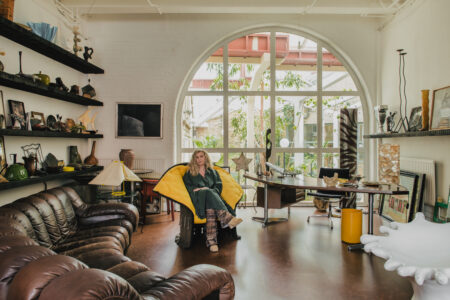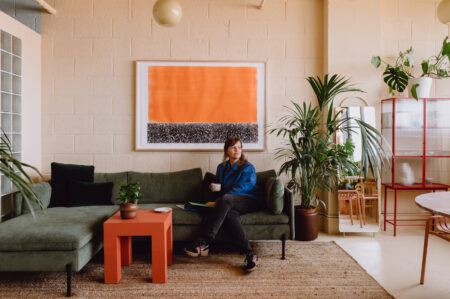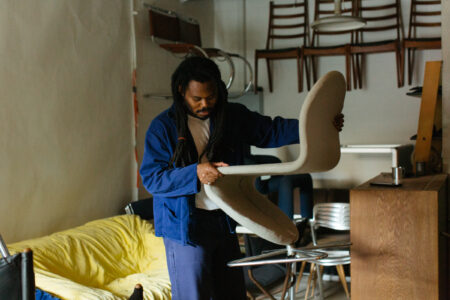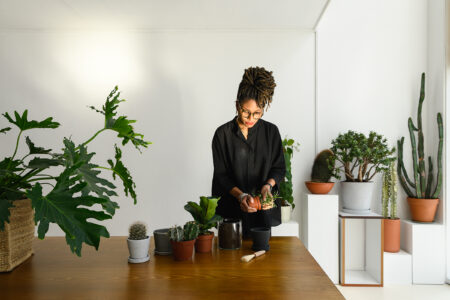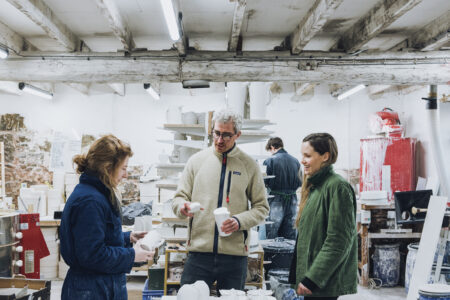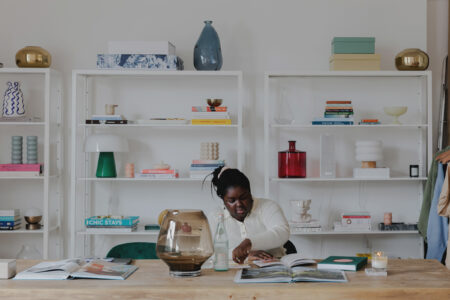Tessa Silva’s milky way of making

Words Billie Brand
Photography Ellen Christina Hancock
Production Harry Cave
Tessa Silva recently made the discovery that she has milk in her blood. “My dad’s from Minas, a dairy-farming state in Brazil,” she says, sipping on black coffee at her studio in Hackney. “So at some point, my family would have been in the business.” The revelation proved poetic, for the artist has spent years developing a material made from surplus skimmed milk. In partnership with an environmentally minded dairy farm in Sussex, Tessa receives small-batch deliveries of raw milk that would otherwise to go waste. She then mixes it with chalk to create a substance that she sculpts into organically shaped vessels – or “chub vases”, as she calls them. “It’s a very special material,” she continues, “and the longer I work with it, the more humbled I am.”
On the sunny autumnal morning of our visit, Tessa’s studio, situated on a quiet mews she shares with a community of creatives, is shipshape. Her nude, bodily objects sit neatly on shelves, alongside books and pocket-sized trinkets, while paintings by her partner hang on the walls. There’s not a splash of milk in sight, but on one of her “messy days” things would look a little different. “It’s not a friendly material,” she says, “I need to have my own workspace.” Tessa has spent five years transforming this former metal workshop, which she stumbled upon on social media, into what she describes as “a home away from home”. As she welcomes us into her world, Tessa tells us how diving down a rabbit hole on pre-plastic materials led her to discover dairy as a medium and marvel at its mythology.


Tessa: “My dad is a carpenter, so I grew up around woodworking. He had a workshop in a tiny shed on our terrace. He was always making and fixing things around the house – and I was often his assistant. Then, as I got older, I became interested in it too. I did my master’s in product design at the Royal College of Art and started doing a lot of spoon carving. It was fun, but with wood you must listen to the material, and I found manipulating it tough. I also found anything that involved the construction right angles tricky. I like lumpy and bumpy forms; the material I work with now lends itself to organic shapes.
“At the RCA, it was drummed into me to do something different. There are so many designers churning objects out into the world, so I had to ask myself: ‘What’s going to be special about what I’m going do?’ Finding a niche was important. I was investigating pre-industrial materials when I came across one that existed in Tudor times made from sour milk and chalk, which was used to create concrete-like floors. It wasn’t very common, so I couldn’t find much information about it, but it was used in Alfriston Clergy House, the first to be purchased by the National Trust. The floor has green moss growing on it now, but it’s been there for hundreds of years. I started looking into it and thinking about how I could create something like it.
“In 2015, I began experimenting with making a protein plastic from milk, without using any additives. The first four years of my practice involved making multiple samples to find a formula that worked. In fact, I only added the chalk element in the last two or three years. I don’t have a lot of patience and I wanted to get to a point where I could start creating objects, but I wasn’t able to produce anything for ages.

“One of my tutors connected me with an organic farm in Sussex. It has a small herd of under 40 cows, which are all organically fed. They live for nine years longer than the average industrial dairy cow. When I spoke to the farmers, they told me they have a waste stream of skimmed milk, which is fed back into the ground. For my material, I need milk without fat content, so it doesn’t rot or go greasy. The farmers, who separate the protein from the fat so that they can create butter and cream, were throwing the skimmed milk away. So, four years ago, I partnered with them and I have been getting deliveries of their waste milk since.
“The more I dive into the history of this ‘chalk and cheese’ material and the mythology surrounding milk, the more interested I become. As my friends have started having babies, I have better understood the human connection to milk as a substance too. It’s a fascinating material to work with.
“One of the things that is most interesting to me is the reaction I get from people about what I do. They find my work shocking; others are grossed out by the organic bodily forms. I find it funny when people say they don’t like my material, but drink milk in their tea. I’m curious about the taboo surrounding materials – especially natural ones. Milk symbolises a weird middle ground between birth and death: it’s a substance we associate with new life; then when it rots, it feels more linked to decay.


“I chose the name ‘chub vases’ because it’s super simple and reflects exactly what they look like. I also want them to appear like I have frozen them in time – like the liquid has been immortalised. I create them by sewing fabric moulds and then pouring the liquid in. The inspiration for that came from the traditional way of setting cheese, which involves wrapping the product in cloths. Once set, the cheese has a fabric imprint on its sides, which I have on my vases too.
“I’ve been making in this studio for about five years. I was working in another shared space when I realised that I needed more room. I found this one on Facebook and when I came to have a look, a guy was living upstairs and there was a metal workshop where my studio is, with materials and tools hanging off the ceiling… But it was affordable. I also love the mews I’m on. I’m the newest arrival; people have been here for 25 years or more and it does feel like a community, something that is rare to find.
“Me and my friend initially took the studio on together and we completely redid it. We built the mezzanine, repainted it and put the sink in. It was proper a renovation project, but having a dad who’s a carpenter made it quite easy. He was very involved in helping us build this space. Now that it’s all mine, I have the freedom to adapt it in whatever way I want – there are no rules about putting holes in the wall or painting them a different colour.


“I have always been space-conscious and I find it hard to concentrate when my surroundings don’t feel right. I like to change things up fairly regularly. As soon as I get a bit tired of things, I reorganise everything – I feel more creative when I’m within a well-curated space. Colour makes a big difference to me as well and I’m always thinking about pigments. I make my mine from natural ingredients – I use beetroot to for pinks, algae to for greens, butterfly-pea flour for blues – and I like my studio to match the palette I’m using.
“I’m in the studio five or six days a week. I particularly like working on Saturdays, when I know that the world around me isn’t. In the winter, I enjoy evenings here because the space is quite cosy. When I’m making, I always have something playing in the background. I usually have NTS Radio on, but I also listen to a lot of podcasts. I’ve been known to go through a whole series in a day.
“When I’m sewing the moulds, the studio is less chaotic. I will do as many as possible and then have an intense day of mixing the milk and chalk. I’ll have rubber gloves up to my elbows and the extractor on. I’ve recently started to make small-scale furniture, such as tables and plinths, which I’m enjoying because it’s more of a challenge. But I love vases – they are the archetypal human-made object and have been around for tens of thousands of years. There are infinite possibilities to them, which is something I don’t think I’ll ever stop exploring.”





